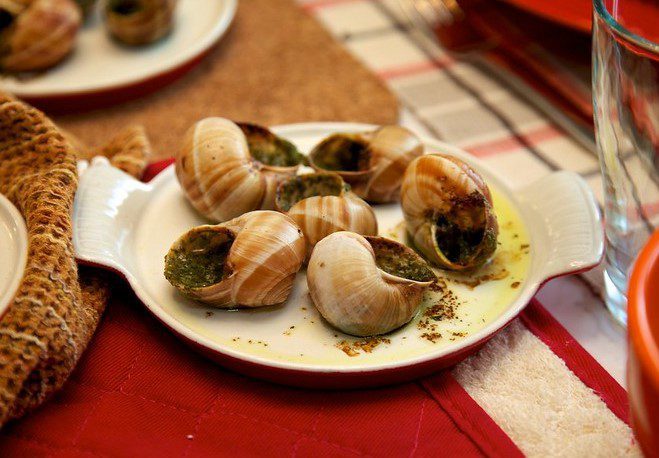
Escargot is the French word for edible land snails. It usually refers to the genus Helix (aspersa or pomatia), the members of which have been a delicacy enjoyed as food for many centuries. Their original ancestor evolved from a single cell organism almost a billion years ago. It was a marine organism until about 250 million years ago when it migrated to solid land and adapted to its new environment. It developed a gastrointestinal tract able to take in food and excrete its indigestible material. It covered itself with a hard protective shell and grew tentacles to help it find nutrients. Being so very slow moving, it entered the language with expressions such as “moving at a snail’s pace.”
There are many kinds of snails in the world. Some can spread diseases, notably schistosomiasis but also other parasites such as Fasciola hepatica, Clonorchis sinensis, and Paragonisimus westermani. Snails have served as food for humans since ancient times when they were easier to find and gather than other livestock. The Romans popularized the practice of eating snails and considered them a delicacy and a symbol of high status. They bred snails in special farms called “cochlearia” and equipped these with special snail shells to provide shelter and encourage growth. As the Roman Empire expanded, so did the tradition of eating snails, eventually spreading to other parts of Europe.
In the medieval period, snails were a common food source for peasants, as they were abundant and easily gathered from gardens and fields. It was not until the Renaissance that snails again gained a high status as a gourmet food, especially in French cuisine, where chefs developed cooking techniques to elevate the snail’s flavor and texture. This marked the beginning of escargot as a luxury dish, often served in aristocratic households and fine dining establishments.
The most prized escargot come from the Burgundy region of France, where Helix pomatia snails are farmed specifically for culinary purposes. These vineyard snails are fed a controlled rich diet to achieve maximum flavor. France consumes the most escargot in Europe, amounting to about 40,000 tons per year. The annual escargot season in France coincides with the spring and early summer months when snails are out of hibernation, making them plump and juicy for gathering. June through August is peak escargot season in France.
Beyond France, escargot is also popular in the cuisines of Spain, Portugal, Italy, Greece, and increasingly all over the world. Asian and African cuisines, for instance, have incorporated snails into their dishes, adding their own unique spices and ingredients to create fusion dishes that blend traditional flavors with the exotic. Escargot has also gained popularity in the US, ideally as a good starter dish with a nice crisp white wine as classic pairing.
Preparation of escargot is very important. Snails meant for consumption are typically purged of mucus or toxic substances before being cooked, raised in special escargot farms in controlled and safe environments. Once cleaned, they are generally prepared by simmering them in water, wine, or broth. The most famous preparation is the classic “escargot à la bourguignonne.” In this, snails are removed from their shells, cleaned, and then cooked in a mixture of garlic, parsley, butter, and white wine. The resulting concoction is spooned back into the snail shells, garnished with breadcrumbs, and broiled.
Escargot tongs and special two-pronged snail forks are used to pull the snail meat out of the shell. Prepared correctly, snails are tender yet slightly chewy, offering a delightful contrast to the rich, garlicky sauce. Escargot often also holds cultural significance. In France, it is considered a symbol of fine dining and sophistication, often associated with romantic evenings in upscale restaurants. Elsewhere snails are also consumed but often prepared differently, reflecting the diversity of culinary traditions around the world and offering an opportunity for appreciating this timeless delicacy in many different ways.

Leave a Reply